Imagine a world where you produce everything that you need. It’ll be challenging for each one of us and practically impossible. This insight can be used when deciding whether to do ReactJS development in-house or outsource it.
Assuming that you have in-house expertise or do not have enough talent onboard, doing it all by yourself can present a series of challenges: You’d have to start from scratch, as you might not even have much idea about ReacJs or how to go about the whole planning, prototyping, testing, development, deployment, and launch journey. And then, let’s not forget the world of efforts and monitoring that goes into app management once it goes live.
Here’s a blog post for you if you are unsure whether to hire an in-house development team or outsource to a reliable React application development services company. You will get familiarized with the basics and will be able to build a roadmap. Let’s get started with a brief introduction to React Js.
What is ReactJS?
For the novice, ReactJS is a JavaScript library. You use this library to build interactive and modern web and native user interfaces (UIs).
But for seasoned developers, ReactJS presents a world of possibilities. They can leverage ReactJS to build truly world-class web and native apps.
Using React Native and Expo, React developers can build cross-platform applications that look and feel like native apps and run across Android, iOS, and more with one single codebase. Developers can also leverage ReactJs to create stunning web applications that load fast and delight customers.
Another noteworthy feature of the ReactJS library is its components. These components are JavaScript functions that you can write using code and markup. For example, if you want to show some content conditionally, you can use an ‘if’ statement.
As a pro-React programmer will tell you, React or ReactJS is a vast landscape of development that you can use to develop secure and scalable applications. Feeling like learning more about ReactJs? Here’s the official website of ReactJS. Now that we have covered a lot of ground on what ReactJs is let’s head toward the top reasons for outsourcing ReactJS development.
Top reasons to outsource ReactJS development
Outsourcing your development project to a reliable development partner can benefit you in multiple ways. Let me share a couple of reasons you should consider engaging a development partner for your development project:
1. Access to the top talent
Think about it. If you choose to build the application in-house, you will need to gather a lot of resources.
You’d need a team of talented developers. You’d need a project manager. You’d need to do all those conceptualizations, planning, prototyping, testing, development, testing, deployment, and everything on your own. You’d also be required to plug into a series of cloud services. All of this would consume a lot of resources.
Outsourcing alleviates all these pains and challenges off your shoulders. You get immediate access to the best talent you can afford. Having seasoned developers, consultants, and managers makes ReactJs development a far more rewarding experience.
2. Faster time-to-market
Faster project delivery is one of the top reasons to outsource ReactJS development. As your development partner has developed tens or hundreds of React applications, the team will have all the expertise and resources to help you achieve faster time-to-market. Taking your digital product to the market faster can yield multiple benefits and help you build a competitive edge.
3. Flexibility in scaling development resources
You can not experience much flexibility if you develop the software product in-house. However, outsourcing to a reliable development partner helps you scale resources up or down based on your project’s needs. If you require additional resources in the future, you can easily add them. You just communicate with your development partner if you do not need them. This flexibility in scaling development resources up or down leads to additional benefits such as cost savings.
Hire for React development outsourcing
You might find a React development company through a reference, a Google search, or other ways. Here are a few steps to ease the process: First, research and shortlist the ReactJS development companies that can help you with your development project. Second, conduct technical assessments. Third, set clear expectations and milestones. Fourth, ensure clear communication. And last but not least, monitor progress and quality.



